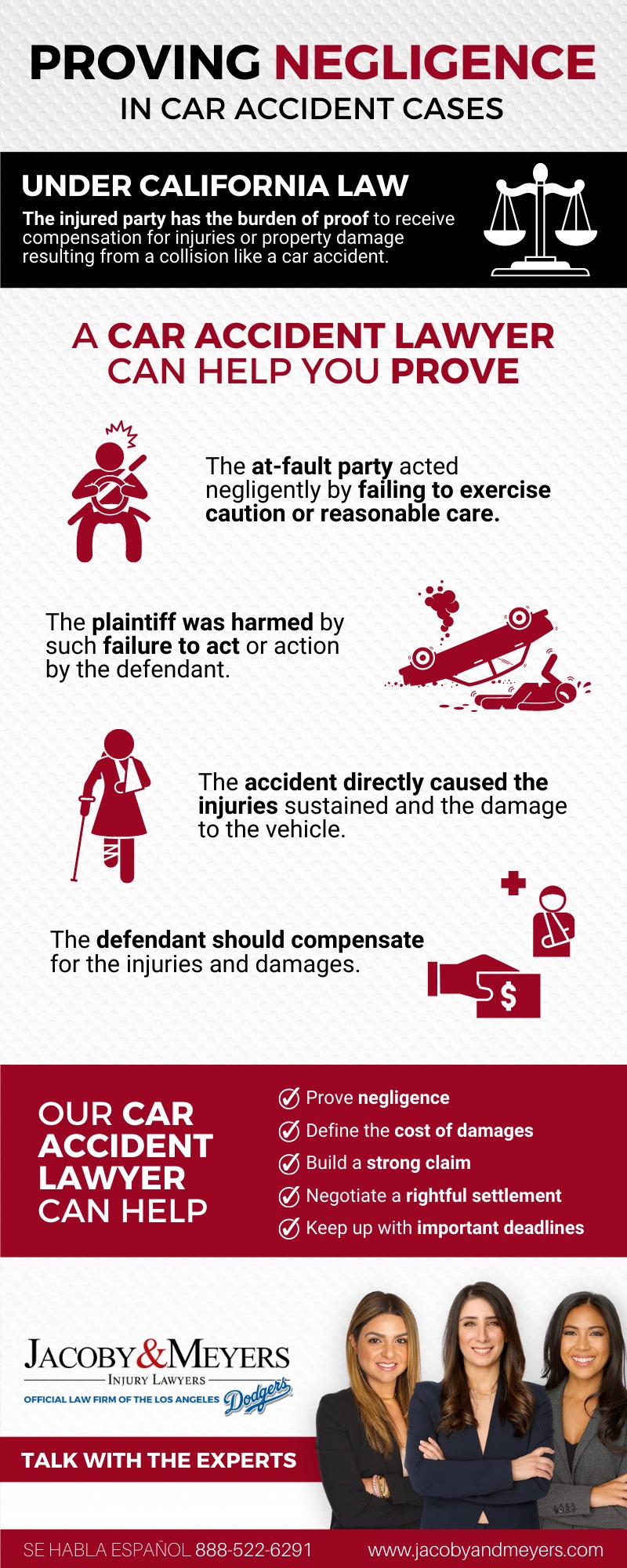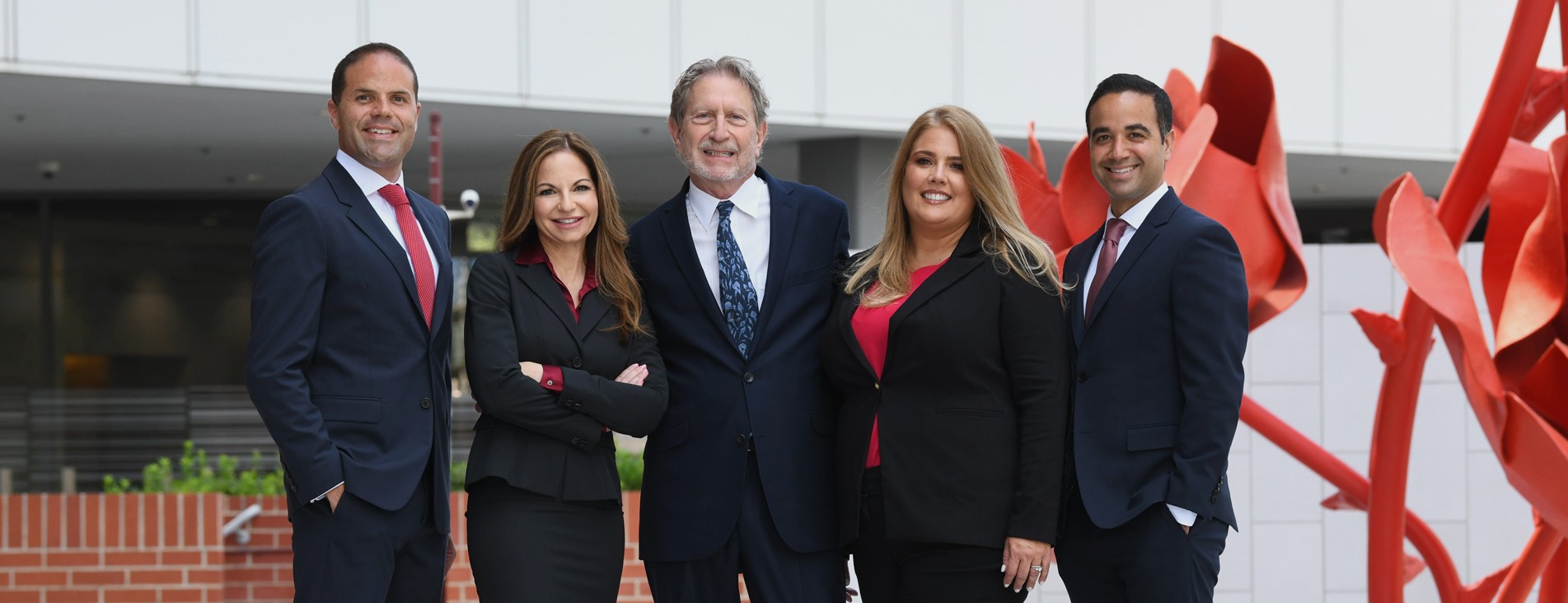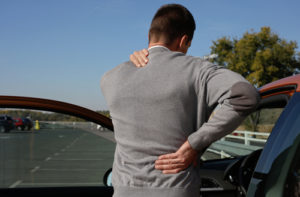
Liability for an automobile accident leads to questions regarding the medical care needed post-accident and property damage. Your attorney can help answer questions regarding who is at fault for the accident. They can also help compel at-fault parties to pay for the plaintiff’s monetary damages. Under California law, to receive compensation for injuries or property damage resulting from a collision like a car accident, the injured party has the burden of proof.
When we represent you, our car accident lawyers in Los Angeles CA, must prove that:
- The at-fault party acted negligently by failing to exercise caution or reasonable care;
- The plaintiff was harmed by such failure to act or action by the defendant;
- The accident directly caused the injuries sustained and the damage to the vehicle;
- The defendant should compensate for the injuries and damages.
Questions regarding liability in accidents involving more than two vehicles require analysis and review of relevant documentation. These include eyewitness statements and police reports by our team of attorneys. In those instances, you can allocate fault. For example, in a 7-car collision, the last car in the chain can still bear liability but to a lesser extent than the 6 cars preceding it.
Los Angeles car accident attorney Jacoby & Meyers has extensive experience researching the causes and responsibilities of accidents and proving those cases in court. Contact Jacoby & Meyers to discuss your accident and the resources they can make available to prove your claim.
How Can You Prove Negligence In Court?
Anyone who suffered injuries due to a third-party driver’s negligence on the road in a car accident may receive legal compensation for his or her damages and bodily injuries. This also includes and extends to the injured party’s vehicle passengers. It applied even when the driver didn’t suffer injuries in the car accident, but the passengers did. Proving negligence is what our team of aggressive litigation attorneys does day in and day out. We gather facts and evidence, which are demonstrable and provable before the court and judge. Our law firm obtains the police report if there is one. We also speak to witnesses and identify the defendant’s insurance, including known coverages or assets.
Negligence in the eyes of the law results when another driver had a duty to drive and operate their car in a safe manner but failed to do so due to inadequate care. Car accident injury lawyers can identify legal arguments, strengths, and visible weaknesses. These depend on the facts gathered and how our team of attorneys evaluates your case. This analysis enables us to prove negligence exists. It also proved that the negligence caused you harm, entitling you to legal monetary damages.
California Law Regarding the Burden of Proof
California is an at-fault state. What that means from a legal perspective is that you must prove that the other driver was at fault before you can pursue a claim on your insurance. The at-fault percentage attributed to you is how much of a reduction in the claim amount you will receive. Put simply, if the insurance company finds that you were twenty-five percent at fault for the accident, then they will reduce your insurance payout by twenty-five percent. It is up to you to show that the other driver was really the one that they should be pursuing. The insurance company essentially says both parties are at fault in this scenario. Therefore, they’re liable to a certain degree or extent- requiring apportionment of the damages.

Proving Negligence in an Injury Claim: Your Path to Compensation
When it comes to personal injury law, proving negligence is the key to unlocking the compensation you deserve. Whether you’ve been involved in a Tennessee car accident or any other type of injury case, understanding how to establish negligence is vital. In this comprehensive guide, we’ll delve into the essential elements you need to prove negligence and secure the compensation you’re entitled to.
1. Establishing the Duty of Care
The first crucial step in proving negligence is demonstrating that you were owed a duty of care by the party you’re taking legal action against. In a Tennessee car accident case, this typically means that the other driver had a duty to ensure your safety by following traffic laws and driving responsibly. If your claim involves someone other than a driver, it’s equally important to show that they owed you a duty of care.
2. Demonstrating the Breach of Duty
Having established the duty of care, the next hurdle is proving that the negligent party breached this duty. This entails showing that their actions deviated from what a reasonable person would consider safe and responsible behavior. Common breaches of care in car accidents include distracted driving, speeding, drunk driving, tailgating, or aggressive road behavior.
3. Establishing Causation
It’s not enough to merely establish negligence; you must also establish a direct link between the breach of care and your injuries. This can be challenging, particularly if you had a pre-existing injury that was exacerbated by the accident. However, your case hinges on demonstrating that the accident was the primary cause of your injury worsening.
4. Documenting Financial Losses
To recover compensation for your accident, it’s imperative to prove that your claimed losses are directly related to the crash. These losses encompass property damage (such as vehicle repair costs), medical expenses, rehabilitation costs, and income losses (including lost wages due to injury-related time off work).
5. Assessing Your Level of Blame
In Tennessee, the legal system employs a system of modified comparative negligence. This means you can still recover damages even if you bear some responsibility for the accident. However, there’s a crucial stipulation: you can only collect damages if you’re less than 50% at fault for the accident. If your fault exceeds this threshold, you won’t be eligible for any compensation.
Building a Strong Case with Compelling Evidence
Effective evidence collection is the linchpin of a successful injury claim. To bolster your case, consider the following types of evidence:
Visual Documentation
Pictures and videos of the accident scene, vehicle damage, and road conditions serve as compelling visual evidence. They vividly illustrate the extent of your injuries and financial losses.
Physical Evidence
Physical evidence, such as the clothing you were wearing at the time of the accident, can demonstrate the physical and emotional trauma you endured.
Police Reports and Witness Statements
While police reports are generally inadmissible as evidence in Tennessee, they are invaluable for tracking down witnesses, reconstructing the accident scene, and leading to other forms of evidence, such as eyewitness testimonies.
Expert Opinions
Statements from repair shops and medical providers provide accurate estimates of your accident-related expenses. These expert opinions are crucial in substantiating your financial losses.
How Jacoby & Meyers Personal Injury Law Firm Can Assist You
If you’ve suffered injuries in a car accident, Jacoby & Meyers is here to help you collect the evidence necessary to strengthen your injury claim. Our experienced team specializes in assisting clients in documenting their injury costs, loss of income, property damage, and pain and suffering. To learn more about your rights and explore your options, contact us for a free case evaluation. You can also request additional resources and information tailored to your situation.
In conclusion, proving negligence in an injury claim is a multifaceted process, but it’s a crucial one for securing the compensation you rightfully deserve. By understanding the key elements and gathering compelling evidence, you can build a strong case that increases your chances of success. Don’t hesitate to reach out to Jacoby & Meyers Personal Injury Law Firm for expert guidance and support on your journey toward justice.
Call or text 888-522-6291 or complete a Free Case Evaluation form








